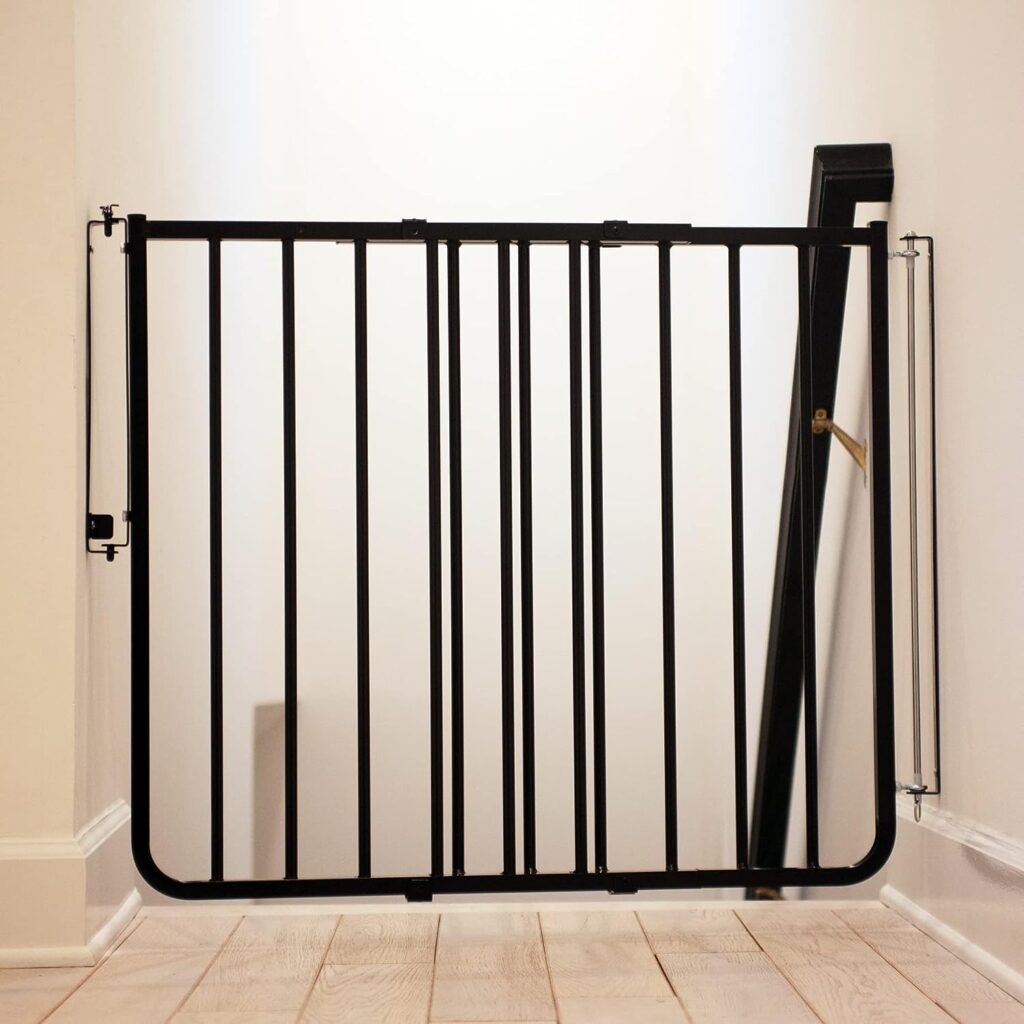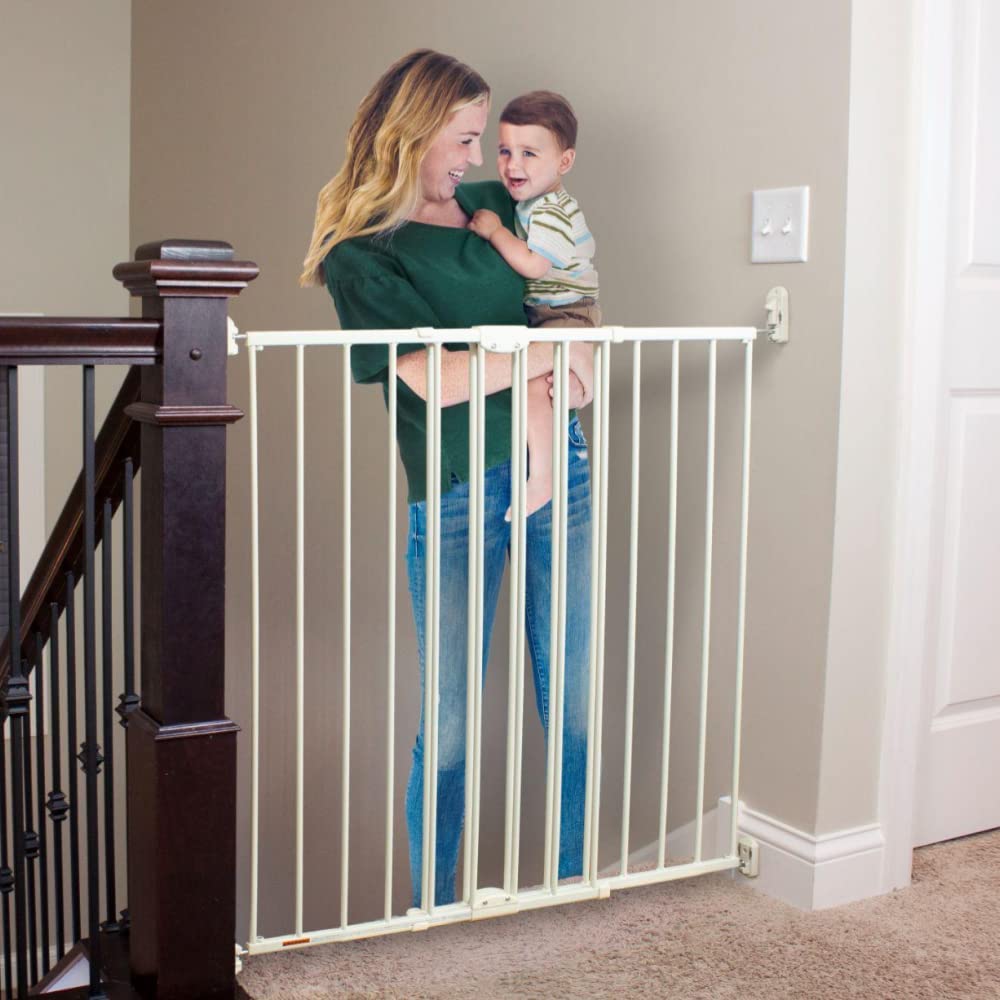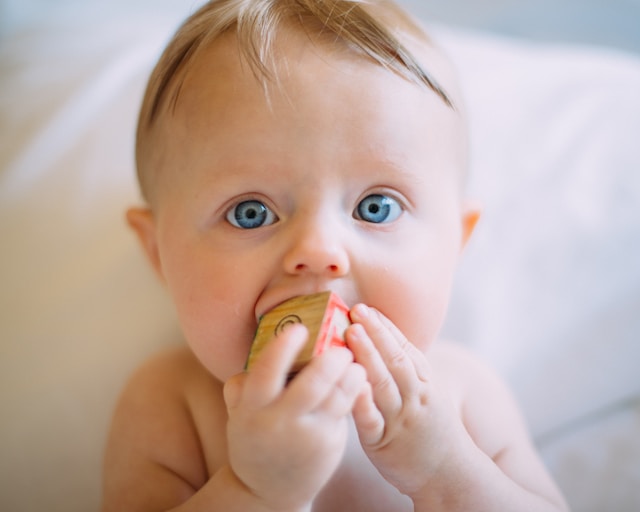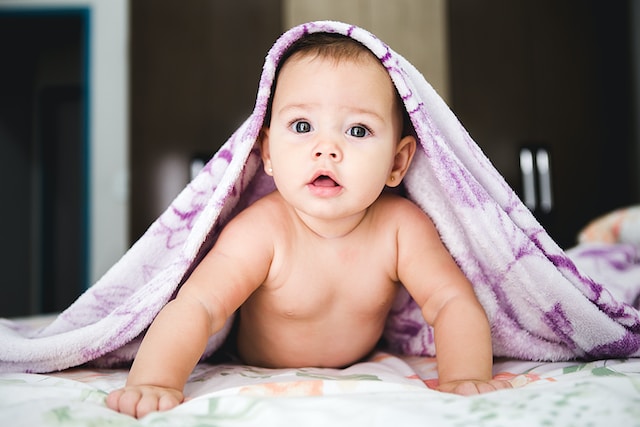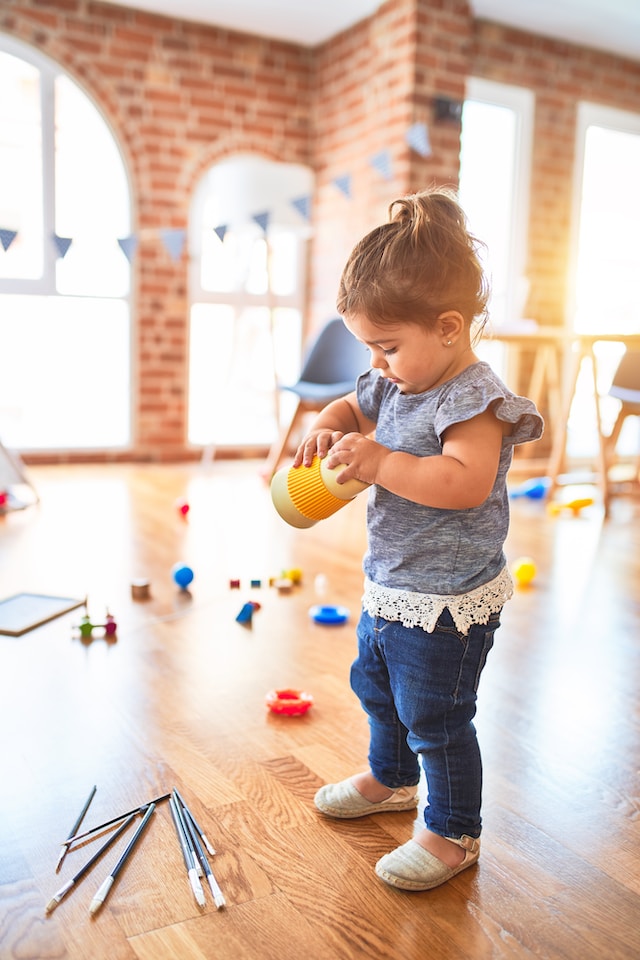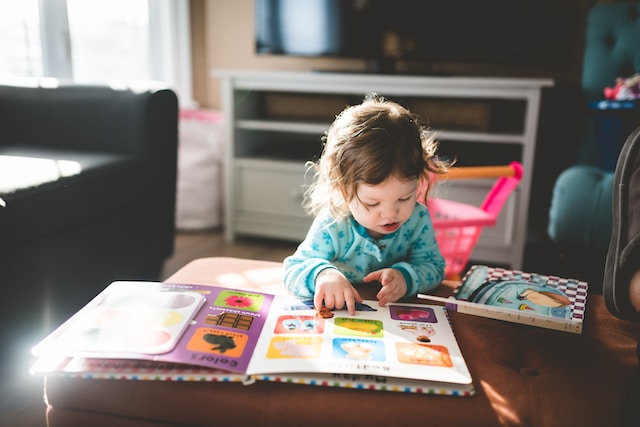Nothing feels better than a warm and real fire in the fall or wintertime, but if you have a baby or small child, fireplaces can be dangerous.
According to Safe Kids Worldwide, in 2018, over 90,000 kids visited the emergency, over 7,000 children were hospitalized, and 320 children died from fire and burn-related injuries.
The good news is there are plenty of safe and effective ways to baby-proof your fireplace so that your family can still enjoy the warmth of a roaring fire.

In the following several sections, we will go over products, how to use them and where you can buy them that will safely and effectively baby-proof your fireplace year-round!
If you’re ready to baby-proof your fireplace let’s jump right in!
Reasons Why You Need to Baby Proof Fireplace
Besides the obvious reasons that fireplaces are hot and can burn children and babies, there are other hazards to consider. Many fireplaces are made out of brick or stone, which could cause a head or facial injury if your child bumps into it.
Additionally, many modern fireplaces, especially in apartments or townhomes, are gas and, if tampered with or played with, could leak harmful toxins into the air you may not even be aware of until it is too late!
Lastly, a lot of equipment goes with fireplaces, such as heavy fire pokers and tongs, fire grates, and heavy logs themselves.
Children are naturally curious and need no invitation to investigate something that piques their interest. Young children especially do not have an innate sense of danger, so they may touch sharp or hot things.
When You Need to Baby Proof Fireplace
Ideally, you’ll baby-proof your fireplace when you baby-proof the rest of your home, which is before your baby even is born. Once your little bundle of joy is here, you will be so concerned with other daily tasks, baby-proofing for an infant who can’t move yet may fall off the radar.
If you do, however, forget or don’t have the time or money to do it ahead of time, you should definitely have it done before your baby starts moving independently.
Most babies learn how to sit up on their own around 5 or 6 months. This is a great age because they can sit and play but don’t go anywhere yet! But hang on tight because before you know it, they will have figured out how to crawl. Once your baby is mobile, you absolutely need to get baby-proofing in place.
How to Baby Proof Fireplace With Baby Gate
Without a doubt, one of the best ways to baby-proof your fireplace is to seal it off and make it inaccessible completely.
If your child cannot reach the fireplace, they cannot get hurt!
The best and most efficient way to accomplish this is with a baby gate, but pay attention because not all baby gates are created equal.
You will want to avoid a free-standing gate because they can simply pull that down.

Your best option is to purchase one that fits around the shape of your fireplace and attaches to the wall.
You can also purchase an all-around baby gate that your child plays in while in the room, but this will affect their mobility. A gated area for them to play in, however, is an excellent choice if you are renting and do not want to make holes in the wall.
Toddleroo by North States 3 in 1 Metal Superyard
The Toddleroo 3 in 1 Superyard is an excellent choice because it is incredibly versatile. You can attach this baby gate to the wall via the included hardware or it can be used as a freestanding play-pen style gate for your child to play in safely.
You can attach this specific baby gate to angled walls, and you can buy extension panels separately if needed.
Costzon Baby Safety Gate
The Costzon Baby Safety Gate offers four different configurations making this an extremely versatile gate to have in your home.
This gate can be used as a playpen for your baby, or you can use it in one of three baby gate shapes to block off the fireplace or room.
You have the wall option to mount the gate or be used as a free-standing guard or fence. When the door is less than 90 degrees open, it will automatically close on its own.
You can attach this specific baby gate to angled walls, and you can buy extension panels separately if needed.
The door can also open either direction, making going in and out of rooms easier than a one-way panel.
When not in use, the baby gate easily folds up for storage.
Regalo 192-Inch Super Wide Adjustable Baby Gate and Play Yard
This baby gate is ideal if your goal is to block off the entire room the fireplace is in. At 192 inches, it covers 16 feet of space!
This gate is an excellent option if you have an open floor plan style home and need to block off a lot of floor space.
Regalo’s super-wide gate has a walk-through door feature that automatically clicks into place behind you, so there is no stressing about having to go back and make sure it is closed.
Dreambaby Royale Converta 3 in 1
The Dream Baby Royal play-yard is a good option for parents who want versatility in how they use their gate.
It has an adjustable shape, so it can be used as a play-yard to keep your baby safely inside, or parents can set it up in a straight or curved position to block your baby from the fireplace.
It comes in three different colors, which means you can match it to your decor, and has a door panel function to make moving about easy for mom and dad.
This baby gate is also highly portable, so it is easy to take along if you visit friends or family who may not have baby-proofing in their home.
Baby Proof Fireplace Hearth
While keeping your baby aware from a hot fire is definitely of the utmost importance, what about when it is not fire season and you take the baby gate down?
The hearth itself presents dangers with it’s hard edges, hard edges, and sharp corners.
There are two different types of fireplace hearths; flath hearths and stepped hearths.
Flat hearths are when the fireplace sets on the ground and there is no ledge in front. This is very common with gas fireplaces. A stepped hearth has a ledge or a step in front usually made out of brick.
1. Flat Hearth
The purpose of a hearth is to provide a barrier between the fireplace and your floor. They also offer an ascetic value making your fireplace pop and appear more decorative.
A flat hearth will be built into the floor in front of your fireplace and extend out to the sides to protect the immediate area around the fireplace. They can be made out of various materials; most commonly, stones, granite, or brick are used.
A flat hearth leaves a clear path for your baby to approach the fireplace, so it is crucial that this area is baby-proofed to protect your child.
#1. Baby-Gate
To baby-proof, your flat heart baby-gates are a great way to go. They block your baby from getting close to the fire but allow your child freedom to move about the room.
If you choose to use a baby gate, consider one of the ones mentioned previously and, if possible, install one that anchors to the wall. As your baby grows and becomes stronger, pressure point gates might not be enough to keep them away from a dangerous spot like a fireplace.
#2. A Soft Mat
Placing a soft mat or non-slip rug over your heart in no-fire weather is probably the simplest and most cost-effective ways to keep your baby from falling down on the hard surface.
Consider something like the Gorilla Grip Rubber Door Mat. It comes in a variety of colors, and because it is made for outdoor use, it is durable and tough and can withstand a lot of foot traffic.
#3. Edge Protectors
Even some flat hearths have a slightly raised edge, or lip can create a tripping hazard for big and little people. If you do not use your fireplace, it’s for decoration only, or it is the off-season, and you don’t want a gate up; if you have a lip, you will need some soft bunting.
The Roving Cove foam corner protector works excellent for flat hearts with a lip. You can also use this product to baby-proof tables, counters, and other furniture with sharp corners.
It is sold in a package with several sets of corner pieces and a long section of tubing you can cut to your desired length, making it very handy and convenient.
2. Stepped Hearth
A stepped hearth presents some additional challenges because of the added risk of bumps and bruises. Most injuries children receive around fireplaces are from cuts and lacerations due to falls.
The raised edge of a stepped hearth is the perfect height for a child to fall and bump their head. Small children may also be tempted to climb onto the ledge and may fall or jump off.
In addition to a baby gate around your stepped hearth, below are some recommended tips to keep your fireplace safe for your baby!
#1. Padded Bumper
Similar to the foam-edged piece you can place around the edge of a table or armoire, there are padded pieces for your fireplace hearth that can also withstand heat so they can stay up year-round!
The Kidkusion Soft Heated Hearth Pad is highly recommended. It is latex-free, BPA free, non-toxic, and covers 90” of the hearth.
#2. Cushioned Seat
If you don’t use your fireplace or want a different look in the off-season, you can turn it into a padded seat with a bench cushion. The downside to this option is that it doesn’t cover the entire edge of the seat, and children may remove it.
However, this may be a great alternative if you are the relative of a baby or small child who comes to visit who doesn’t need their hearth baby-proofed all the time.
#3. Foam Play Mats
Some parents have gotten very creative when it comes to baby-proofing their fireplace hearth. One solution is to use interlocking foam squares to create a cushioned wall along the edge of your hearth.
If you want this to be a semi-permanent fixture, at least until your baby is old enough to stop worrying about bumps, you will need some heavy-duty double-sided tape to make them stick.
This is a fun option because they come in a variety of colors and patterns, so you can make them match our room or make them more playful for your baby.
#4. Restrict their Access
This idea may seem a bit harsh, but if you’ve tried other baby-proofing methods and your child is determined to get near that fireplace, you may need to cut off their access completely.
You can do this by blocking off the room with secured baby gates, attaching a baby gate to the wall around the fireplace, or purchasing a stand-alone play yard so they can be in the room with you.
A great option for a stand-alone play yard is the Fortella Cloud Castle Foldable Playpen. It is sturdy, solid, and provides some textures, activities, and colors to engage your baby.
The playpen gives your child plenty of room to move about as it covers 25 square feet, and it can be folded up and put away when not in use, so it is not a permanent fixture in your room.
Baby Proof Fireplace Doors
Doors of all kinds pose a hazard to little hands. But fire doors pose an extra hazard as they can become hot and could burn your child’s hand or if they are not secured your child may be easily able to open them.
#1. Test the Door
One of the most important things you can do to baby-proof your fireplace door is to test them. Fireplace doors are required to be manufactured with children’s safety in mind. The door should latch securely so that your child cannot accidentally open it.
#2. Check the Temperature
If you plan to take down the baby gate once the fire has died away, you must be sure to check the temperature of the door before you do so. The door’s temperature because it can say hot for quite some time after you’ve put out the fire.
A stick-on thermometer might be helpful, so you know when the temperature has returned to a safe level. Stick-on thermometers aren’t designed to measure temps super high, but they will register once it’s dropped back down below 100 in most cases.
When in doubt hold a digital forehead thermometer up to the glass. You want the glass to return to room temperature before you take the gate down.
Baby Proof With Carbon Monoxide Detector
Carbon monoxide detectors are a must in any home regardless of if you have kids or not but they are extra important if you have gas appliances in your home.
Many modern fireplaces are gas operated and do not rely on real wood, therefore it is imperative you have a carbon monoxide detector close to your fireplace.
#1. Plug-In Detector
Carbon monoxide detectors, much like smoke detectors, need batteries or electricity to run on. Because carbon monoxide directors don’t need to be up high like a smoke detector, however, you can find plug-in ones that use your home’s electricity as opposed to batteries that need to be changed frequently.
The Kiddie AC Carbon Monoxide Detector is a great affordable pick! It lasts up to ten years and has a tamper-resistant feature that will alert you when it has been unplugged.
#2. Combination Detector
If a detector can detect one type of gas, great! But what if it can detect two? The Kiddie AC Carbon Monoxide and Explosive Gas Detector does just that.
This plug-in detector is a great way to keep your family safe from the threat of gas leaks in your home. The digital display shows you the most current CO reading and has a peak memory to record the highest level ever recorded.
If you prefer not to plug it in or need it in a place where there is no plug, it also takes a 9-volt battery and can be mounted on the wall or ceiling.
The detector has two different alarm sounds, so you know if CO or an explosive gas is causing the potential threat.
#3. Battery-Operated Alarm
If you prefer the traditional battery-operated alarm then check out the X-Sense Carbon Monoxide Alarm Detector. This modern CO alarm has a digital display that shows the current measurement in the home.
It boasts a ten-year sensor life and runs on three 1.5 v AA batteries. It can be ceiling mounted, leaving your outlets free and keeping the detector away from children who may try to unplug it or press buttons.
Baby Proof With Smoke Detector
Smoke detectors are another must-have in your home with or without children. If you have a fireplace, you should place an additional smoke detector in the same room.
According to the U.S. Fire Administration, there were 1,900 fatal residential fires in the United States in 2019 and an additional 7,000 fires that resulted in injury. Those numbers don’t even take into account fires that resulted in damages alone.
The majority of fires are accidental. By having a working smoke detector in your home, you drastically reduce the chance of your home and family from being a statistic.
#1. X-sense Wireless Interconnected Smoke Alarm
If you have a big home or your fireplace is on another floor from your bedrooms, this is an excellent smoke detection system.
The detectors are all linked wirelessly, so when smoke is detected in one area of the house, it alerts all the other detectors.
Most smoke detectors don’t alert you unless they have detected smoke on their own.
The X-sense wireless system could save you valuable time since your entire house will know at once there is an issue.
#2. Standard Battery-Operated Smoke Detector
Most people have smoke detectors in their homes that are battery-operated. This is a great option as long as you check and change the batteries every six months.
You should have at least one smoke detector per level of your home, but it is recommended to put an additional one in the room with the fireplace and outside of your bedroom door.
#3. Connected to your Alarm System
Many alarm and security companies now offer smoke detectors that are wired into your alarm system. If this is available to you, it is highly recommended because as soon as your smoke alarm goes off, the fire department is alerted.
The downside is, if you burn popcorn in your microwave, you have to talk to your alarm company to stop the fire trucks from coming out, but this type of system can give great peace of mind for people when sleeping or when they are away from home.
What To Do If Your Baby Gets Burned
#1. Minor Burns
If your child receives a minor burn from briefly touching a hot fireplace door or other hot surfaces, run the burn under cool (not cold) water or apply a cool compress.
It is possible the burn may blister; do not pop the blister. Cover the burn with a clean gauze pad or non-stick bandage.
You can give your child over-the-counter pain relievers to help with the discomfort and pain.
#2. Second-Degree Burns
Second-degree burns can be minor, but they can also be life-threatening if not adequately treated. If your child sustains a more severe burn, you should seek medical treatment.
SIgns of a second-gree burn include a wound that is white, very red or dark brown, an irregular pattern, a wet or seeping wound, or a wound that is causing intense pain.
These burns are often the result of cooking accidents, severe sunburn, or fire.
Before you head to the doctor, remove clothing from the area if possible, use cool (not cold water) or a compress, and have the child drink plenty of water.
Apply clean gauze to cover the wound. Do not apply home remedies or ointments to the burn.
#3. Severe Burns
If your child sustains a severe burn, you should immediately call 9-1-1. Burns can be life-threatening, cause damage to muscle and nerves, and leave permanent disfiguration.
If your child receives a third-degree burn, they will likely need to be hospitalized for care, so they must get medical attention right away.
What To Do if Your Baby Inhales Too Much Smoke
#1. Rest
If your child has been exposed to excess smoke, they will need a lot of rest and care, and time for their lungs to repair.
Chances are, if your child has been exposed to a dangerous amount of smoke, you have sought out medical treatment.
It is essential to follow your doctor’s instructions and allow your child plenty of time to rest and recuperate.
#2. Keep Your Child Away From Smoke
After your child has been exposed to excessive amounts of smoke, it is crucial to keep them away from all types of smoke.
Do not let anyone smoke near them and keep them away from events like campfires and cookouts.
#3. Call the Doctor
If your child has been exposed to too much smoke, it is possible the signs won’t show up until hours later. If you notice your child is coughing a lot, is having trouble breathing, or is coughing up brown or bloody mucus, seek immediate medical care.
If your child has a cough that lingers for several days after smoke exposure that does not seem to be getting better, make an appointment with their pediatrician.
Wrapping Up
Fireplaces can be a warm spot of gathering and delight in a family’s home, a place to come together at ten ends of a busy day to relax, but they also present several hazards that need to be addressed.
Since most fireplace-related injuries are accidents, taking the time to properly baby-proof your fireplace could be the difference between a wonderful family spot and an unfortunate or even tragic accident.
Take the time before your baby arrives to assess your fireplace, where the dangers lie, and what options are realistic and affordable to you in order to create a safe environment for your little bundle to be.
















